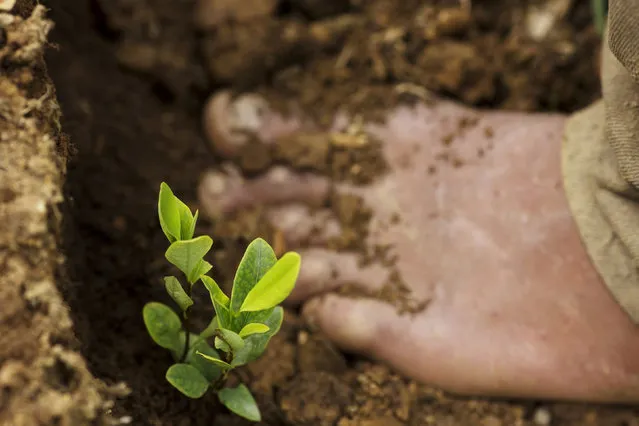
In this March 13, 2015 photo, a seedling grows next to a barefooted Donato Mosco, as he weeds a coca field, in La Mar, province of Ayacucho, Peru. Peru overtook Colombia in 2012 as the world's No. 1 cocaine-producing nation. (Photo by Rodrigo Abd/AP Photo)
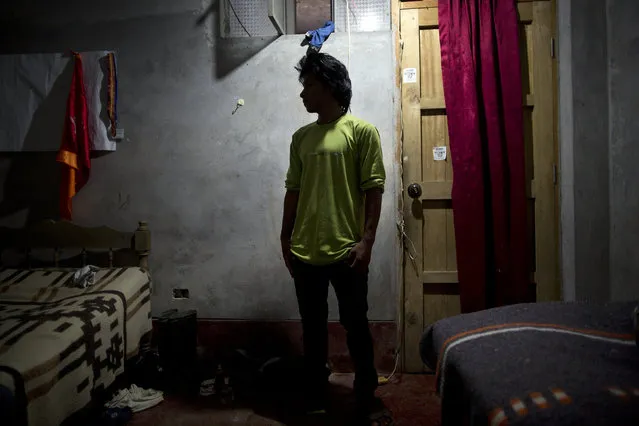
In this March 14, 2015 photo, Mardonio Borda,19, poses for a picture during an interview, in La Mar, province of Ayacucho, Peru. A native Quechua with broken Spanish and a sixth-grade education, Borda is among untold hundreds of cocaine backpackers who make the difficult and dangerous trek up Andean mountain paths first carved by their pre-Incan ancestors. (Photo by Rodrigo Abd/AP Photo)
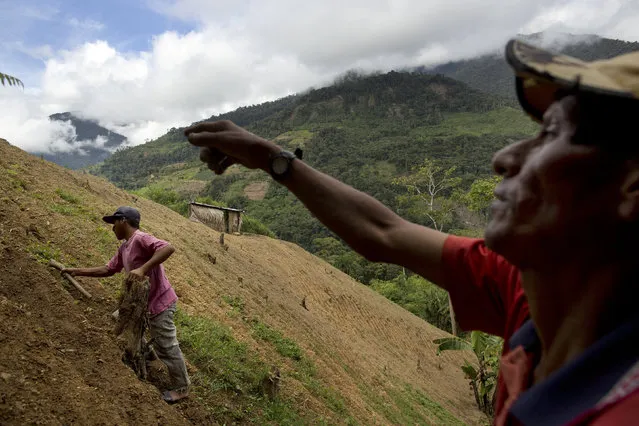
In this March 13, 2015 photo, coca farmer Alfredo Mosco, 44, right, instructs his young employee Donato Mosco, during the weeding of a coca field, in La Mar, province of Ayacucho, Peru. Hauling cocaine out of the remote valley is about the only way to earn decent cash in this economically depressed region where a farmhand earns less than $10 a day. (Photo by Rodrigo Abd/AP Photo)
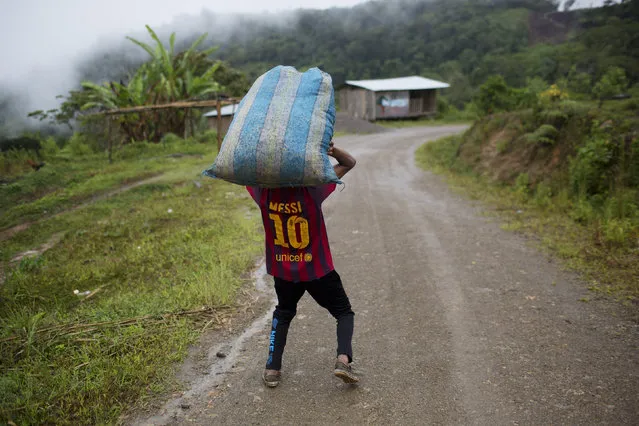
In this March 16, 2015 photo, Jhorlis Huallpa, 17, carries a bagful of tarps, to be used for drying coca leaves, in La Mar, province of Ayacucho, Peru. Hauling cocaine out of the valley is about the only way to earn decent cash in this economically depressed region where a farmhand earns less than $10 a day. Beyond extinguishing young lives, the practice has packed Peru's highland prisons with backpackers while their bosses evade incarceration. (Photo by Rodrigo Abd/AP Photo)
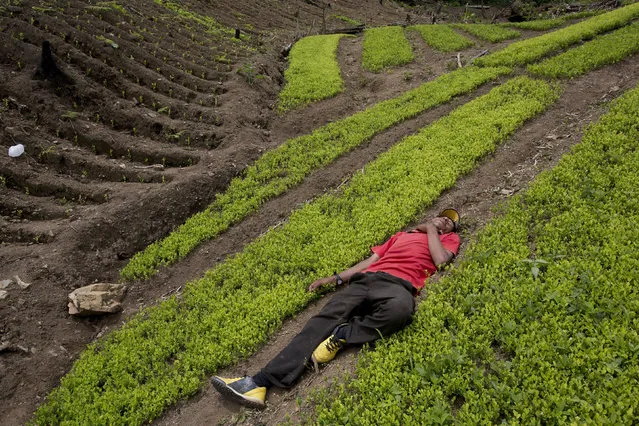
In this March 13, 2015 photo, coca farmer Alfredo Mosco, 44, who had polished off a bottle of cane liquor by midday, sleeps in his field of coca seedlings, in La Mar, province of Ayacucho, Peru. Mosco is a small coca farmer who provides work for young villagers. (Photo by Rodrigo Abd/AP Photo)
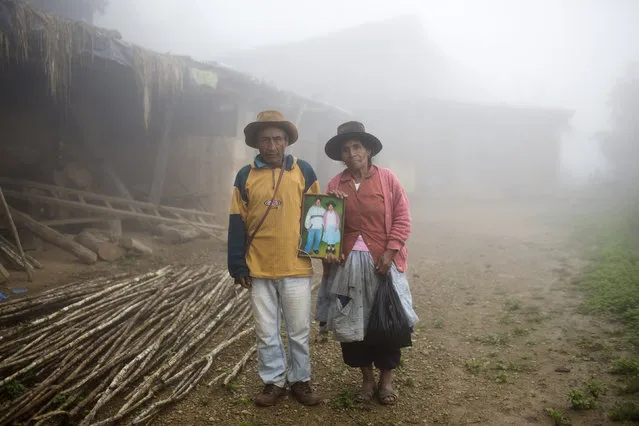
In this March 15, 2015 photo, Julio and Rufina Galvez pose for a picture holding a portrait of their late son Yuri, outside their home, in La Mar province of Ayacucho, Peru. The 25-year-old university student had gotten his father's permission to haul coca in a backpack to pay for his agronomy studies, his mother said. Yuri was found face-up on a mountain trail, with bullet wounds to his head, stomach and arm, in a March 2013 cocaine smuggling trip. (Photo by Rodrigo Abd/AP Photo)
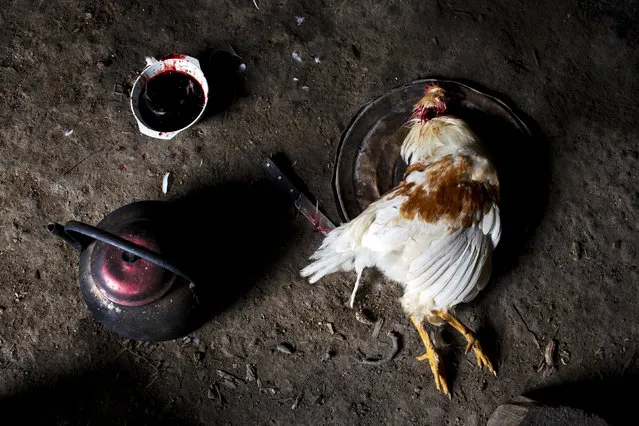
In this March 15, 2015 photo, a slaughtered chicken sits on a pan lid, to be used in a soup for a special dinner marking the second anniversary of the death of Yuri Galvez, in La Mar, province of Ayacucho, Peru. Galvez, 25, was killed in March 2013 during a cocaine smuggling trip. Deaths of cocaine backpackers often go unreported. Bodies lack identification papers, and villagers quietly bury them. (Photo by Rodrigo Abd/AP Photo)
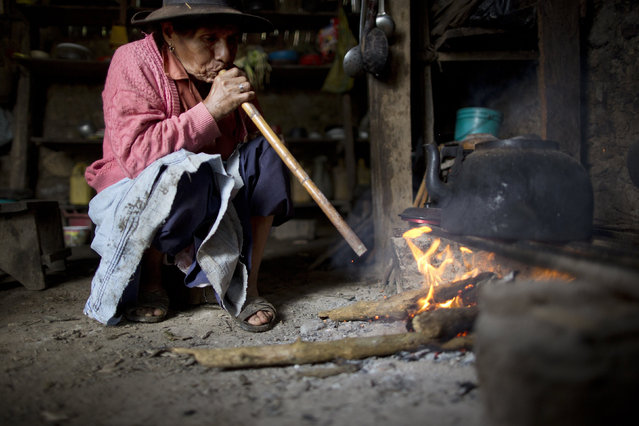
In this March 15, 2015 photo, Rufina Galvez blows into a cane reed to stoke a fire while preparing a special chicken broth to mark the second anniversary of her son's death, in La Mar, province of Ayacucho, Peru. He adored her, ferrying her around Ayacucho on his blue motorcycle, buying her groceries, making sure she always had cell phone minutes, she said. Her son, a university student, had gotten his father's permission to haul coca to pay for his agronomy studies. In March 2013, her son was found face-up on a mountain trail, with bullet wounds to his head, stomach and arm. (Photo by Rodrigo Abd/AP Photo)
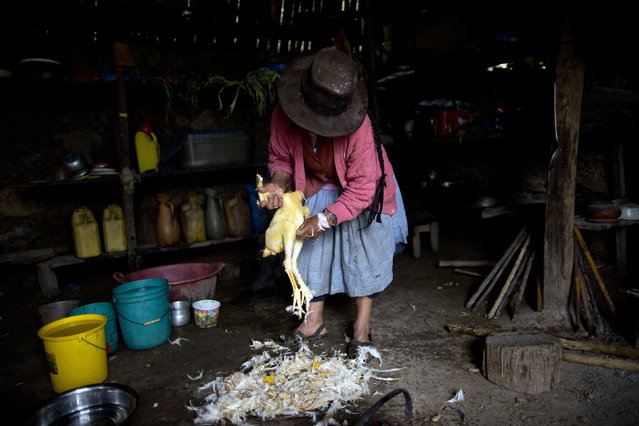
In this March 15, 2015 photo, Rufina Galvez plucks a chicken in preparation for a special dinner to mark the second anniversary of her son's death, in La Mar, province of Ayacucho, Peru. Yuri, a cocaine backpacker, always checked in by phone she said. So when he didn't call after a March 2013 smuggling trip, his mother turned to reading coca leaves to try to divine his fate, tossing them on her skirt as is customary. “The leaves fell spine-up, a bad sign”, she said. (Photo by Rodrigo Abd/AP Photo)
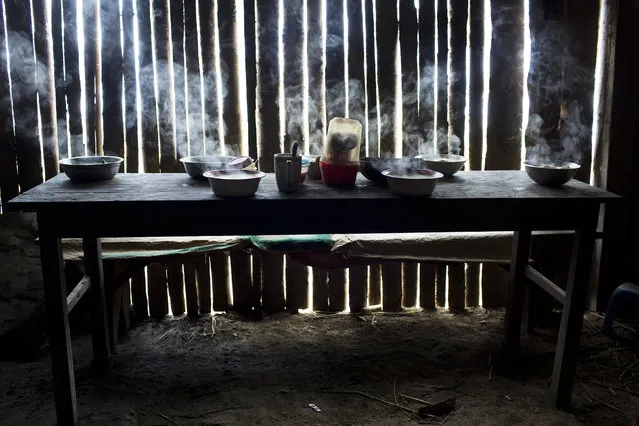
This March 15, 2015 photo shows steaming bowls of chicken soup on a table set for a special meal marking the second death anniversary of cocaine backpacker Yuri Galvez, in La Mar, province of Ayacucho, Peru. Galvez, 25, was found dead two years earlier after a smuggling trip with other backpackers. (Photo by Rodrigo Abd/AP Photo)
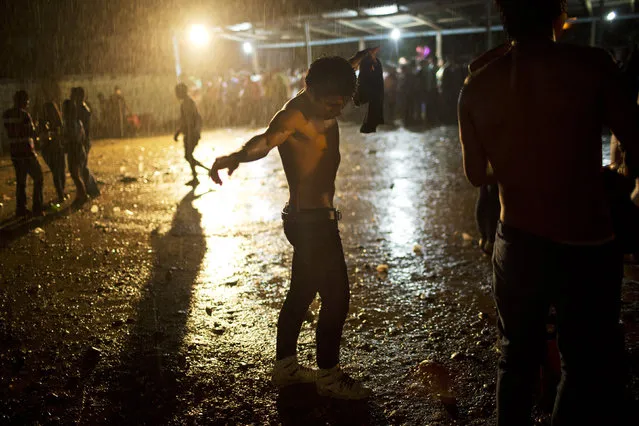
In this March 16, 2015 photo, a young man dances under a heavy rain during a concert by huayno singer Ely Corazon, in La Mar, province of Ayacucho, Peru. The average cocaine backpacker, or mochilero, is typically recruited by relatives and friends – often at festivities where liquor flows. They tend not to tell their parents, who nearly always disapprove. (Photo by Rodrigo Abd/AP Photo)
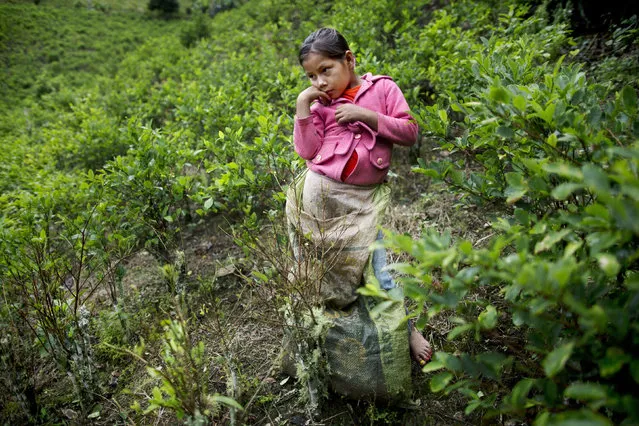
In this March 16, 2015 photo, Janet Curo, 9, takes a break from harvesting coca leaves with her mother, in La Mar, province of Peru's Ayacucho state. Janet skipped school to help her mother in the coca fields. They are in the remote Apurimac, Ene and Mantaro river valley, where 60 percent of Peru's cocaine originates. (Photo by Rodrigo Abd/AP Photo)
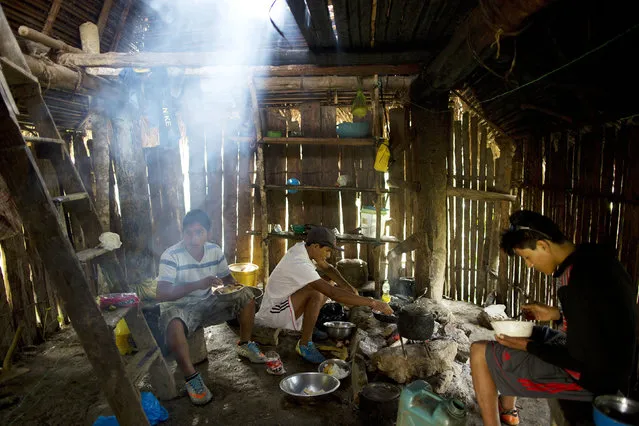
In this March 13, 2015 photo, Donato, from left, Delfin, and Jony, eat breakfast before starting their work day of weeding coca fields, in La Mar, province of Ayacucho, Peru. Peru's cocaine trade is highly decentralized, run by scores of extended families who sell to representatives of foreign cartels. (Photo by Rodrigo Abd/AP Photo)
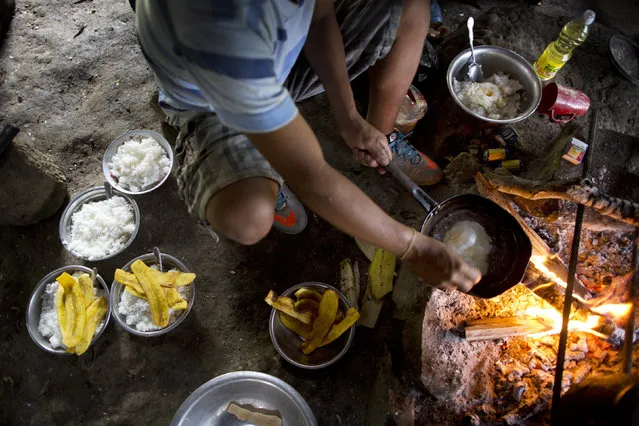
In this March 13, 2015 photo, Donato fries an egg over an open fire to add to his breakfast of rice and plantain, before starting his work day of weeding coca fields, in La Mar, province of Ayacucho, Peru. Roughly one third of the 305 metric tons of cocaine that the U.S. government estimates Peru produces each year travels by foot by way of cocaine backpackers or mochileros, as they are known locally. (Photo by Rodrigo Abd/AP Photo)
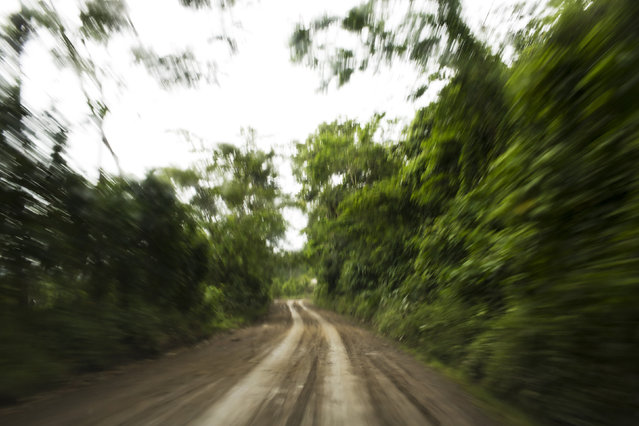
This March 16, 2015 photo, a rural road is seen in La Mar, province of Ayacucho, Peru. While authorities say most of the drugs in the region are now flown out, backpacking is dependable in the rainy season, cheaper than hiring a pilot and plane – and key to evading police checkpoints. Backpackers, or “mochileros”, (“mochila” is Spanish for backpack), have been hauling cocaine this way for nearly two decades. (Photo by Rodrigo Abd/AP Photo)
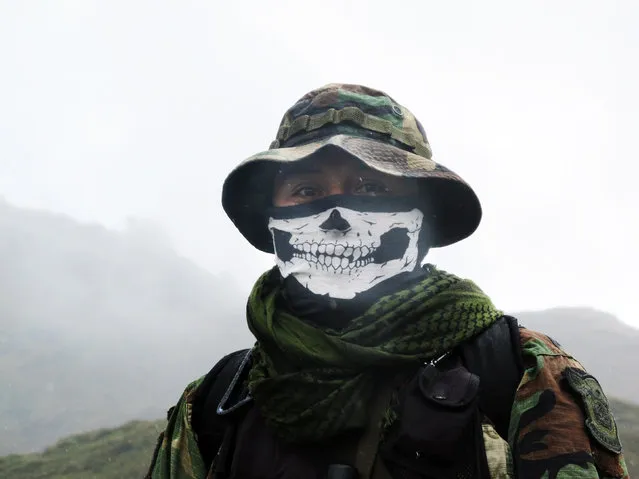
In this February 28, 2015 photo, an elite policeman of the DIRANDRO counternarcotics police agency walks through a puna or highland plane in Husnay, Peru, after an unsuccessful mission to try to arrest drug-toting backpackers hiking up from the world's No. 1 cocaine-producing region. The backpackers can choose from myriad routes in a half dozen corridors of sparsely populated steppe. They often hike at night, to avoid detection. Few know before they are arrested that they face eight- to 15-year prison sentences. (Photo by Rodrigo Abd/AP Photo)
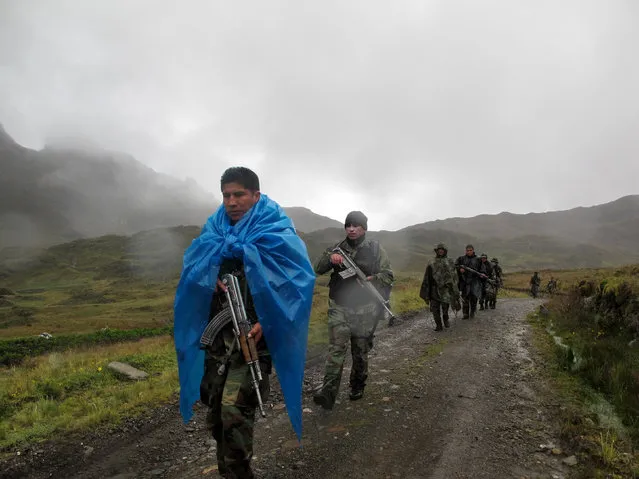
In this February 28, 2015 photo, a patrol of elite DIRANDRO counternarcotics police walks through a puna or highland plane in Husnay, Peru, after an unsuccessful mission to try to arrest drug-toting backpackers coming from the world's No. 1 cocaine-producing region. Its commander, Maj. Juan Tardio, said the unit spotted 15 backpackers less then a mile away early that morning but the smugglers were too far away to capture. His patrol had good intelligence, he said, but chose the wrong path of three options. (Photo by Rodrigo Abd/AP Photo)
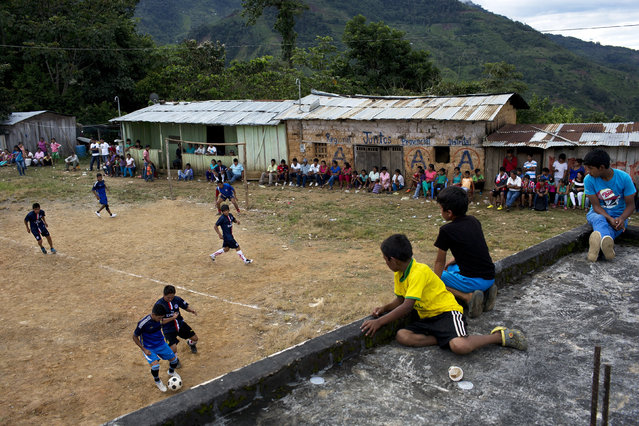
In this March 15, 2015 photo, young men compete in a multi-village soccer tournament, in La Mar, province of Ayacucho, Peru. A hardy lot, cocaine backpackers are mostly native Quechua speakers and hail from the isolated communities that suffered the worst atrocities of Peru's 1980-2000 dirty war with Shining Path rebels. (Photo by Rodrigo Abd/AP Photo)
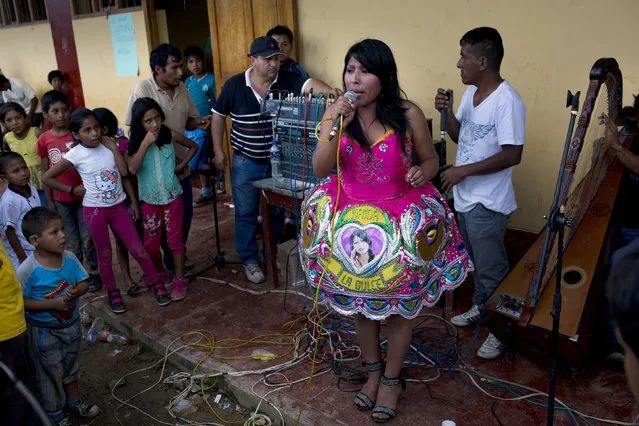
In this March 15, 2015 photo, huayno singer Nanda la Dulce performs during a multi-village soccer tournament, in La Mar, province of Ayacucho, Peru, located in the remote Apurimac, Ene and Mantaro river valley, where 60 percent of Peru's cocaine originates there. Huayno traditional Andean folk music. (Photo by Rodrigo Abd/AP Photo)
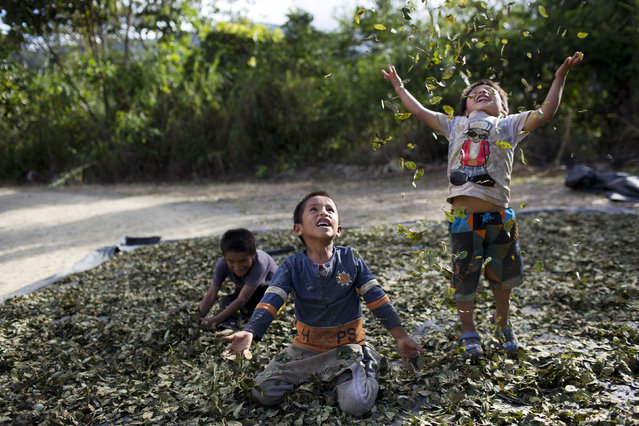
In this March 13, 2015 photo, Yohan, 4, from left, Cristian, 7, and Angelo, 6, playfully toss coca leaves into the air, singing: “I have a lot of money, look at all the money I have”, in La Mar, province of Ayacucho, Peru. Hauling cocaine out of the remote valley is about the only way to earn decent cash in this region where a farmhand earns less than $10 a day. Beyond extinguishing young lives, the practice has packed Peru's highland prisons with cocaine backpackers while their bosses evade incarceration. (Photo by Rodrigo Abd/AP Photo)
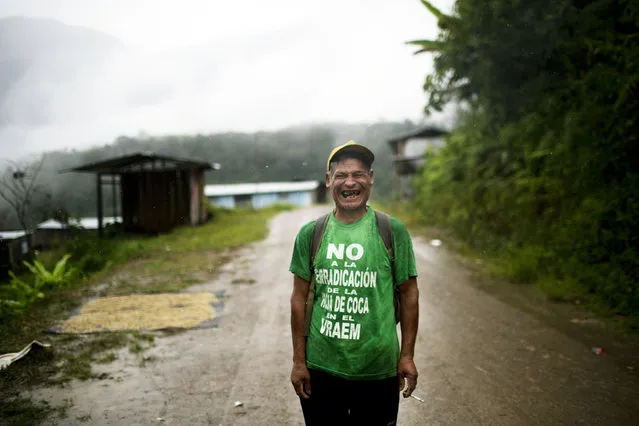
In this March 15, 2015 photo, Fortunato Farfan laughs while posing for a photo in La Mar, province of Ayacucho, Peru. Fortunato is wearing a T-shirt with a phrase that reads in Spanish; “No to coca eradication in the VRAEM”. VRAEM is the acronym for Valley of the Apurimac, Ene and Mantaro rivers, where sixty percent of Peru's cocaine originates. (Photo by Rodrigo Abd/AP Photo)
12 May 2015 12:40:00,
post received
0 comments
